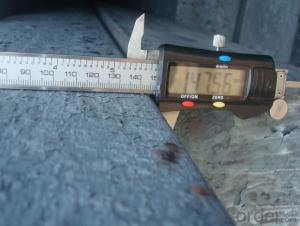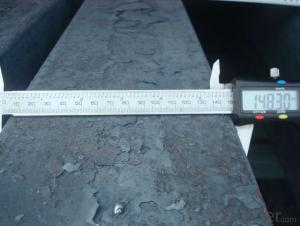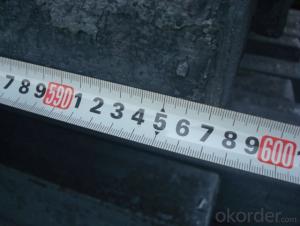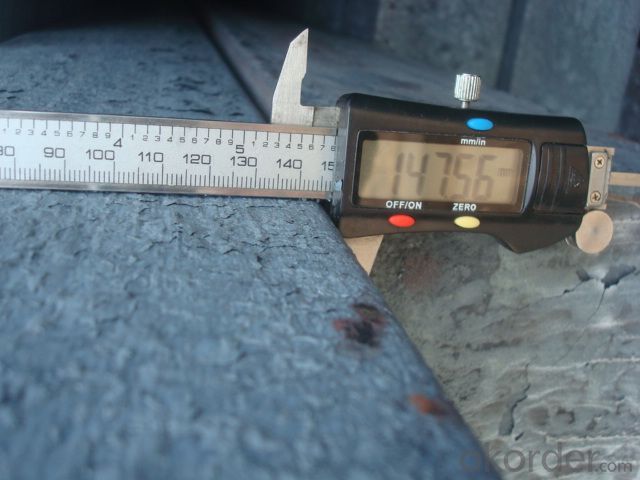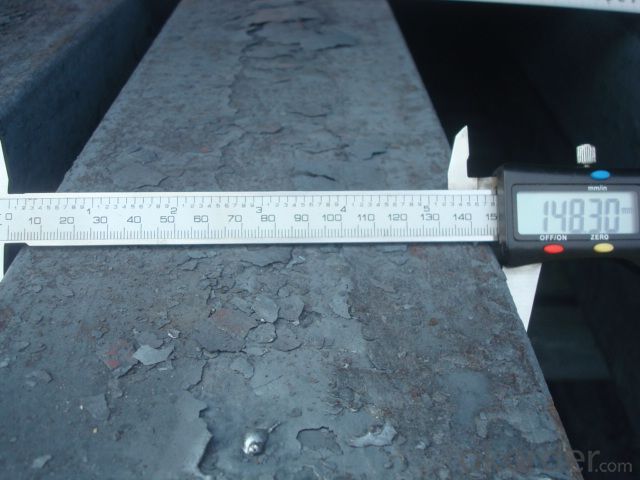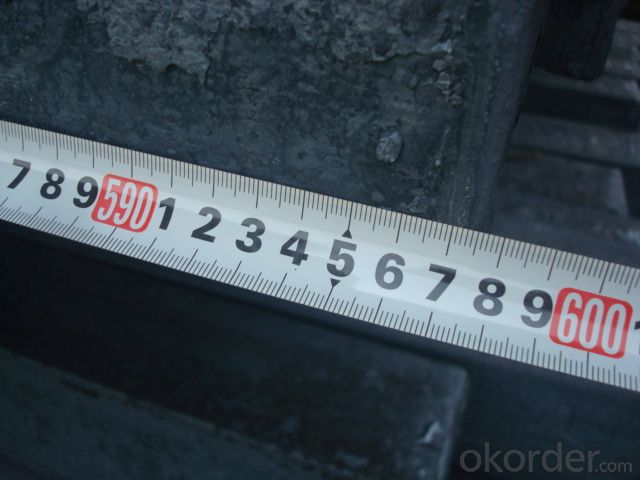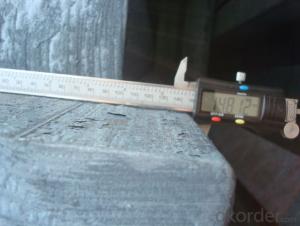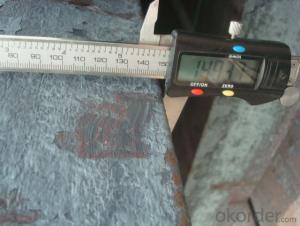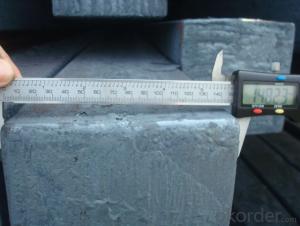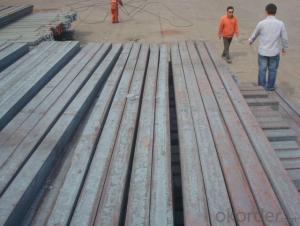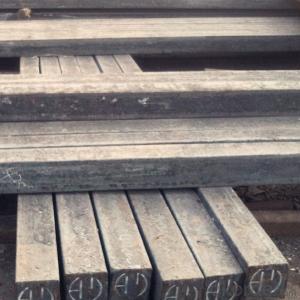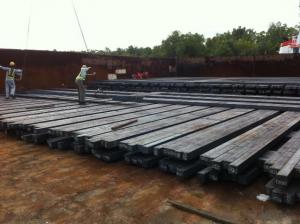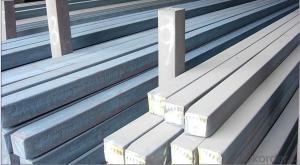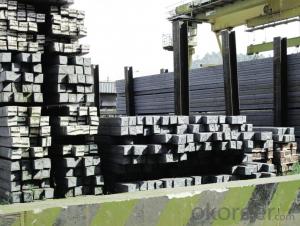Square Steel Billets 70mm 100mm 130mm 150mm 3SP
- Loading Port:
- Tianjin
- Payment Terms:
- TT OR LC
- Min Order Qty:
- 1000 m.t.
- Supply Capability:
- 30000 m.t./month
OKorder Service Pledge
OKorder Financial Service
You Might Also Like
STEEL BILLET
1.Brief description
Steel billet(ingot) by cogging or breakdown of semi-finished products, is the raw material of all kinds of steel mill. Billet section of square, round, flat, rectangular and abnormity of several kinds of, mainly related to the shape of rolled products.
2.Features
Rectangular billet continuous casting billet and mainly general carbon steel, low carbon low silicon cold-rolled material, high quality carbon structural steel, high strength low alloy steel, special steel, etc.
The billet is mainly divided into two kinds from the shape:
Slab: cross section width and height of the ratio of the larger, mainly used for rolling plate.
Billet: equal cross section width and height, or a huge difference, mainly used for rolling steel, wire rod. ,
Steel billets have distinct characteristics as compared with already furnished steel bars and products. Billets have a specific grain structure, which enables the metal to be processed more intricately. Steel billets are also known for their malleability and ductility, especially when exposed to varying temperatures during shaping and molding.
3.Processing
Steel billets are considered fresh and raw, and they must undergo a series of manufacturing processes before they can be used for various purposes. Billets are made by means of freezing molten liquid, and are later exposed to extremely low temperatures in order to allow the metal to take shape and solidify in chemical structure. The temperature manipulates the metal's physical properties, and tones its strength and durability. The subsequent processes provide the metal's curved mold design so that it can fit the allotted space provided by other machines, which complete the finishing procedures.
4.Pictures
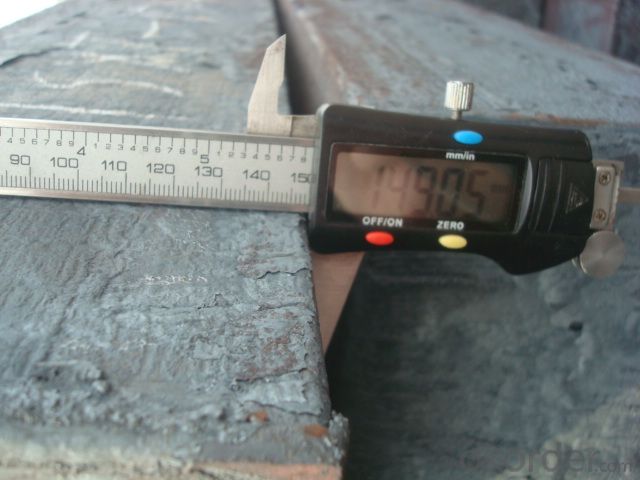
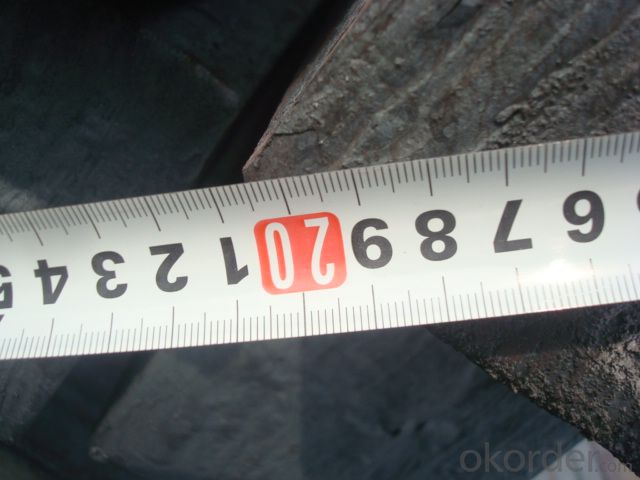
5.Usage
Billets, or ingots (as they sometimes referred to), are not of practical use until they have been formed into more functional shapes and sizes. While they have already been put in the furnace, they still require a series of shaping and molding procedures such as hot and cold working, milling and cutting before they are sold in hardware stores, or used for different applications. The unformed billets, however, can be used in striking currency such as coins and as reserves, similar to gold bars.
6.Detailed specification
Hot rolled billet steel
Size: 50x50mm-180x180mm
Steel Grade: 3SP, 5SP,Q195,Q235,Q255,Q275 Length:3m-12m
MOQ: 1000MT/size
Payment term: TT or LC
Packing: in bulk , bundle
Shipment: by container , bulk vessel
Packaging Details: bundles with steel strips or as customers's requirements
Delivery time: 15-30 days after the deposit
Loading port:Tianjin, or other port China
Origin : China
Inspection:Third party inspection before loading.
- Q: Are there any alternative materials to steel billets in certain applications?
- There exist several alternative materials to steel billets in certain applications, encompassing the following: 1. Aluminum: Exhibiting a lightweight nature and resistance to corrosion, aluminum serves as a prevalent substitute for steel in situations where reducing weight holds significance, particularly in the aerospace industry. 2. Copper: Possessing ductility and high conductivity, copper frequently finds usage in electrical and plumbing applications, offering an alternative to steel billets when elevated electrical conductivity becomes necessary. 3. Titanium: As a lightweight and robust material, titanium commonly serves in scenarios requiring both strength and resistance to corrosion, notably in the automotive and aerospace industries. 4. Composite materials: Carbon fiber reinforced polymers and similar composite materials increasingly serve as alternatives to steel in critical applications where weight reduction and high strength prove imperative, such as aircraft construction and high-performance sports equipment. 5. Plastic: For applications not demanding substantial strength or durability, plastic can substitute steel billets. Plastic showcases a lightweight quality, cost-effectiveness, and ease of molding into diverse shapes. When selecting an alternative material to steel billets, it remains crucial to consider the specific requirements of each application, as each material possesses its distinct properties and limitations.
- Q: How are steel billets inspected for surface defects?
- Steel billets are inspected for surface defects through visual inspection, magnetic particle inspection, and ultrasonic testing. Visual inspection involves a thorough examination of the surface for any visible defects such as cracks, pits, or rough spots. Magnetic particle inspection uses magnetic particles and a magnetic field to identify any surface or near-surface defects that may not be visible to the naked eye. Ultrasonic testing utilizes high-frequency sound waves to identify internal and surface defects by analyzing the reflected waves. These inspection methods ensure the quality and integrity of steel billets before further processing.
- Q: How are steel billets used in the manufacturing of food processing machinery?
- Food processing machinery relies on steel billets for the production of various components and structures. These billets undergo heating and rolling processes to form steel bars, rods, or sheets of different shapes and sizes. These steel products are then utilized in the construction of the framework, body, and other parts of the machinery. Steel's high strength and durability make it an ideal choice for food processing machinery, which often operates in harsh conditions and requires resistance to corrosion, wear, and high temperatures. Steel billets are carefully selected for their quality and suitability for the intended application. When constructing food processing machinery, steel billets are employed in fabricating crucial components like cutting blades, mixing paddles, conveyor belts, and grinding plates. These components are vital for the efficient processing and handling of food products, ensuring consistent quality and safety. Furthermore, steel billets are also used in manufacturing structural supports, frames, and housing for machinery. These structures provide the necessary stability, rigidity, and support to ensure the proper functioning and longevity of the food processing equipment. In conclusion, steel billets play a vital role in the manufacturing of food processing machinery as they provide the essential raw material required to create durable, reliable, and efficient equipment. The quality and characteristics of steel contribute to the performance, safety, and hygiene standards demanded in the food processing industry.
- Q: How are steel billets used in the production of automotive exhaust systems?
- Automotive exhaust systems rely heavily on steel billets as a vital element. These solid blocks of steel serve as the primary material for manufacturing various parts and components of the exhaust system. To begin the process, the steel billets are heated in a furnace to a specific temperature, which softens the steel and makes it malleable. Once heated, the billets are then molded and shaped into different components of the exhaust system, such as pipes, mufflers, and catalytic converters. The shaping process can be accomplished through hot rolling, cold rolling, or extrusion, depending on the desired shape and properties of the component. Following the shaping process, further treatment is carried out to enhance the strength and durability of the steel billets. This treatment may involve heat processes like quenching and tempering, which improve the steel's hardness, toughness, and resistance to corrosion. These treatments ensure that the exhaust system components can endure the harsh conditions they will encounter, including high temperatures and corrosive gases. Once the steel billets have been shaped and treated, they are assembled and welded together to form the final exhaust system. This involves joining the various components, such as pipes and mufflers, using welding techniques like arc welding or laser welding. These welding processes guarantee secure connections between the components, preventing any leaks or failures in the exhaust system. In summary, steel billets are of utmost importance in the production of automotive exhaust systems as they provide the necessary raw material for shaping and forming the various components. Their exceptional strength, durability, and resistance to high temperatures and corrosion make them an ideal choice for manufacturing exhaust systems capable of withstanding the demanding conditions associated with automotive use.
- Q: How are steel billets used in the manufacturing of oil and gas components?
- Steel billets play a crucial role in the manufacturing process of oil and gas components. These billets serve as essential materials and are created through a process known as casting. In this process, molten steel is poured into a mold and allowed to solidify into a rectangular shape, resulting in semi-finished products. Once formed, steel billets are utilized in various ways to produce components for the oil and gas industry. One common application involves their use in the production of pipes, which are vital for transporting oil and gas from reservoirs to processing facilities or end-users. Depending on project requirements, steel billets can be further processed to create seamless or welded pipes. Aside from pipes, steel billets are also employed in the manufacturing of other important oil and gas components such as valves, fittings, flanges, and pressure vessels. These components are crucial for ensuring the safe and efficient operation of oil and gas facilities, as they facilitate proper flow control, connection, and containment of fluids under high pressures and temperatures. The utilization of steel billets in the manufacturing process of oil and gas components offers several advantages. Firstly, steel is widely recognized for its strength, durability, and resistance to corrosion, making it highly suitable for the harsh and demanding operating conditions of the industry. Additionally, steel billets allow for flexibility in terms of size, shape, and composition, enabling manufacturers to produce components tailored to meet specific project requirements. In conclusion, steel billets play a critical role in the production of oil and gas components. They provide the necessary strength, durability, and versatility required for the safe and efficient operation of the industry.
- Q: What are the main applications of steel billets?
- Steel billets are semi-finished products that are used in various applications across different industries. The main applications of steel billets include: 1. Construction: Steel billets are commonly used in the construction industry for the production of structural steel. They are used to manufacture beams, columns, and other load-bearing elements in buildings and infrastructure. Steel billets provide strength, durability, and high load-bearing capacity, making them ideal for construction projects. 2. Manufacturing: Steel billets are also used in the manufacturing industry for the production of various metal products. They are often used as raw materials for the manufacturing of pipes, tubes, rods, wires, and other metal components. Steel billets can be easily shaped and formed into different sizes and shapes, making them versatile for manufacturing purposes. 3. Automotive Industry: Steel billets are extensively used in the automotive industry for the production of various components and parts. They are used to manufacture engine parts, chassis components, suspension systems, and other critical automotive components. Steel billets offer excellent mechanical strength and heat resistance, making them suitable for demanding automotive applications. 4. Machinery and Equipment: Steel billets are also utilized in the machinery and equipment industry. They are used to manufacture gears, shafts, bearings, and other components that require high strength and durability. Steel billets can withstand heavy loads and provide excellent resistance to wear and tear, making them essential for machinery and equipment manufacturing. 5. Energy and Oil Industry: In the energy and oil industry, steel billets are widely used for the production of pipes and tubes. They are utilized in the construction of pipelines for transporting oil, gas, and other fluids over long distances. Steel billets provide the required strength, corrosion resistance, and pressure containment necessary for such applications. Overall, steel billets are crucial in various industries due to their excellent mechanical properties, versatility, and ability to be shaped into different forms. Their applications range from construction and manufacturing to automotive, machinery, and energy industries, contributing to the development and growth of multiple sectors.
- Q: 100Q235 steel can only be rolled from billets of Q235?Or a billet can be rolled into Q195~Q215 and other models of steel?Is there a detailed classification of billets? Do you have GB?
- The same type of steel, such as low carbon steel, the grade and composition design, but also look at the performance, therefore, a steel production process due to the abnormal quality, by the high grade and low grade sentenced to drop, but sales loss.......
- Q: How are steel billets used in the manufacturing of automotive parts?
- Steel billets are an essential raw material used in the manufacturing of automotive parts. These billets, which are typically short, solid pieces of steel, serve as the starting point for various automotive components. Firstly, steel billets are heated and then passed through a series of rolling mills to convert them into different shapes and sizes. This process, known as hot rolling, allows the steel billets to be transformed into bars, rods, or sheets that can be further machined or formed into automotive parts. The automotive industry relies heavily on steel billets to produce a wide range of components, such as engine blocks, crankshafts, suspension parts, and chassis frames. These parts require high strength and durability to withstand the demanding conditions of vehicles. Engine blocks, for example, are typically made from cast iron or aluminum alloys produced from steel billets. The billets are melted and poured into molds to create the desired shape, which forms the foundation of the engine. Similarly, crankshafts, which transfer power from the engine to the wheels, are often forged from steel billets to ensure strength and precision. Suspension parts, such as control arms and torsion bars, also rely on steel billets for their manufacturing. These parts need to withstand the forces and impact of the road, and steel provides the necessary strength and resilience. Billets are machined and shaped to create the required geometry and then assembled with other components to form the suspension system. Additionally, steel billets are used in the production of chassis frames, which provide the structural integrity and support for the entire vehicle. These frames are typically made from steel tubes or sections formed from billets. The billets are shaped, welded, and joined together to create a strong and rigid framework that gives stability and ensures safety. In conclusion, steel billets play a crucial role in the manufacturing of automotive parts. With their versatility and strength, they are transformed into various components that form the backbone of vehicles, ensuring durability, performance, and safety on the road.
- Q: Can steel billets be used in the production of consumer electronics?
- No, steel billets are primarily used in the production of construction materials and machinery, rather than consumer electronics which typically require more specialized materials such as semiconductors, plastics, and alloys.
- Q: What does the billet of the steel plant refer to?
- The steel billet is the continuous casting machine by smelting steel plant casting into the blank, in the middle of products before entering the rolling process, the section size will be decided by rolling steel.
Send your message to us
Square Steel Billets 70mm 100mm 130mm 150mm 3SP
- Loading Port:
- Tianjin
- Payment Terms:
- TT OR LC
- Min Order Qty:
- 1000 m.t.
- Supply Capability:
- 30000 m.t./month
OKorder Service Pledge
OKorder Financial Service
Similar products
Hot products
Hot Searches
Related keywords
